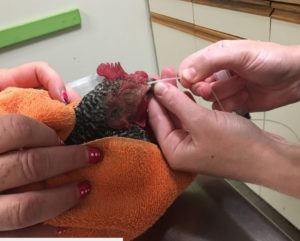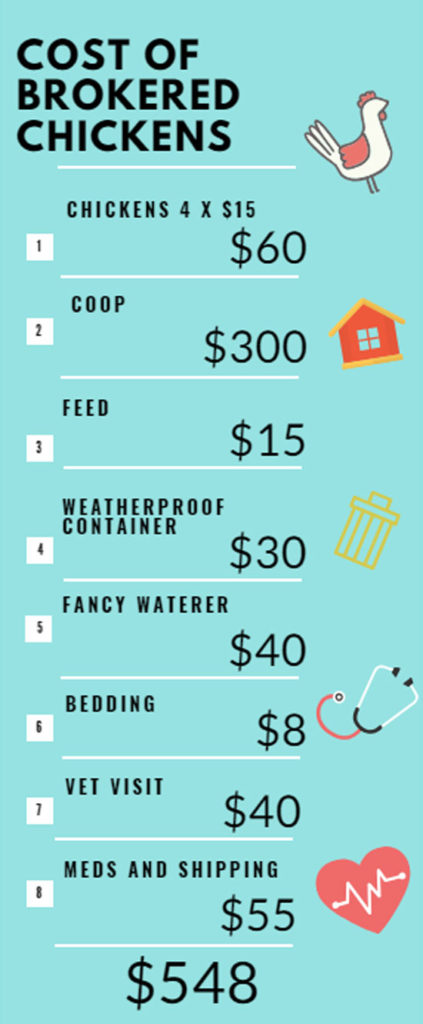Did you catch the foreshadowing in my last post? Rose had been renamed Suzy. If you are at all familiar with the Community Chickens podcast then you know that, to us, Suzy may be a cursed name!
I should have known better. I should have seen the signs. Two days before it really hit me that there was a problem, Rose was sitting in the house while the other girls browsed the pen. I should have checked and rechecked, but I didn’t.
Discovering and Issue
What did I finally notice? When feeding the girls, I noticed that Suzy wasn’t attacking the food like the other golden girls. When she looked at me, one eye was shut, her beak was dirty, and she clearly had little energy.
I followed the instructions given by Kaylee Vaughn earlier this year: What to do (and not do!) for a Sick Chicken: Part 1
I immediately separated her from the others. She was put in a dog crate in the nice, quiet garage with food and water. Thankfully, she was eating and drinking. After that, I cleaned out all of the bedding in the coop and washed the food and water dishes.
After sanitizing the coop I went back for a closer inspection of Suzy. Her nostrils were covered in mucus, and her breathing was gurgly. Her hind feathers were dirty and her vent was caked. The poor thing was in need of some help! I gave her a warm, gentle bath. I loosened the feces around her vent and washed it away. After the bath, I dried her off and then trimmed the feathers below her vent to prevent more build-up.
Our Office Visit
The next day we set up a visit to the vet. An exotic pet hospital is my choice over a livestock veterinary, simply because they likely have more avian experience. I explained that she was having respiratory distress and was lethargic. They got us in within a few hours.

In the exam, the veterinarian noticed that she was thin, and guessed that this illness had been coming on for some time. She remarked that chickens are prey animals and that their natural instinct when they aren’t feeling well is to hide because they are extra vulnerable.
Her crop was empty, indicating that even though I had witnessed her eating, it hadn’t been substantial. After explaining to the doctor how I acquired my chickens she nodded and began her explanation of something I already knew. Getting my chickens from a broker was risky business. Not only had they been shuffled from place-to-place with little care for biosecurity, but we actually knew nothing about their origins, vaccines, age, or the health of the other animals they had lived with. A chicken coming from a situation like this was, in her words, “a poster-chicken for disease.”
The stress from all of the moving would weaken the immune system, the lack of biosecurity on top of that just adds the likelihood that a chicken would be sick.
She was breathing through her mouth by this point because her nostrils were so clogged. After listening to her chest the veterinarian diagnosed her with pneumonia and an upper respiratory infection.
Treatment Options
At this point, we discussed treatment options. She asked me questions like:
“Do you eat her eggs?”
Do you eat her eggs? If yes, and if you plan on continuing to eat her eggs then there are limited options of medications that are approved.
“Will she be around the other chickens?”
If she is around the other chickens how will you be able to tell the eggs apart? How would you medicate only her? This is also where we went over my biosecurity measures.
“Do you want to identify the specific illness, or offer a generic treatment?”
This one comes down to time and money. If we would identify the illness to treat it specifically we would need to run a panel. The panel would cost $70 and take 3 days to get the results. At that point, we would look back to the other questions again depending on the recommended treatment.
To that, I simply asked, “Do you think she would still be alive by the time we get the results?”
We decided to treat generically. The bad news was that the local farm stores did not carry the medication and I would have to order it. Two-day shipping was better than a three-day test, I suppose.
After choosing our treatment plan the vet sucked out Suzy’s beak, providing temporary relief. I was sent home with a syringe and instructions on giving her food and water.

Treating Suzy
Suzy received her food and water via a syringe. I continued to offer her food and water to graze freely. She received warm soaks and towel drying to keep her clean and comfortable. She was so lethargic at this point that I could set her on the floor and walk away to do something else without the fear of her going anywhere.
Suzy’s meds showed up at my desk Thursday morning. My lovely boss let me run home to medicate Suzy, but she had passed by the time I got there.
Poor Suzy had a lot against her and unfortunately didn’t make it. The veterinarian told me “I can’t advise you to prophylactically treat the other birds because I haven’t seen them.” She went on to state that on chicken farms if there was a bird like this, they may destroy all of the animals and start over because it would be more cost-effective. Despite the vague “maybe advice” that I had received, the other chickens seemed fine and I decided to monitor them closely, but hold off on treatment.
Buying adult chickens was a choice I made to save myself time and effort, but my poor execution has made up the savings that I had planned on. Below is the current breakdown of what I have paid for with my poster chickens.

Update: After two weeks there have been no other illnesses in the flock. The remaining golden girls are doing just fine.













